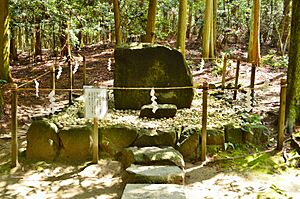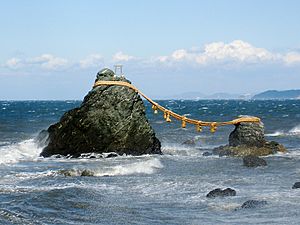Iwakura rock facts for kids
Iwakura (岩倉) is an old Japanese belief. It means that certain rocks are very special. People in ancient Shinto thought these rocks were homes for Kami (gods or spirits). The word "Iwakura" can also mean the special rock itself, which people worship.
Contents
What is Iwakura?
Since ancient times, people in Japan have believed in nature worship. This means they thought gods and spirits lived in nature. They believed these spirits were in things like trees, mountains, and especially rocks. This belief is also called animism.
In early Shinto practices, people believed gods came down to special rocks. These rocks were called shintai. Sometimes, a special area was set up around a rock. This area, called a himorogi, became the center of their worship. It showed the powerful presence of the gods.
Over time, people started building permanent shrines. These shrines became the main places where gods were believed to live. But even today, you can still see sacred trees and stones at many shrines. These often have special ropes called shimenawa tied around them. This shows they are still considered sacred.
Besides rocks, people in Japan also worship other parts of nature. This includes sacred forests like Chinju no Mori. They also worship islands, like Okinoshima, which was once a forbidden area. Mountains like Mount Miwa, fire, waterfalls, and even weather like wind, rain, and lightning are also seen as sacred.
Sacred Rock Sites
Some places have special arrangements of rocks. These are believed to be ancient ritual sites. One type is called Iwasaka. It's thought to be a sacred area centered around a rock. Another similar idea is a banjiki. This is like a stone circle, where stones are arranged in a ring. It acts as a boundary, marking a sacred space. This boundary helps keep the area holy.
Some researchers believe that the worship of rock formations goes back a very long time. They think it might even have started in the Jōmon period. They suggest that some rock arrangements were made by people. These arrangements might have shown certain shapes, directions, or even star patterns. However, other experts believe that these rock rituals became more common later, during the Kofun period.
Gallery
See also
- Shinto shrine
- Kannabi
- Himorogi
- Megalith
- Okinoshima






